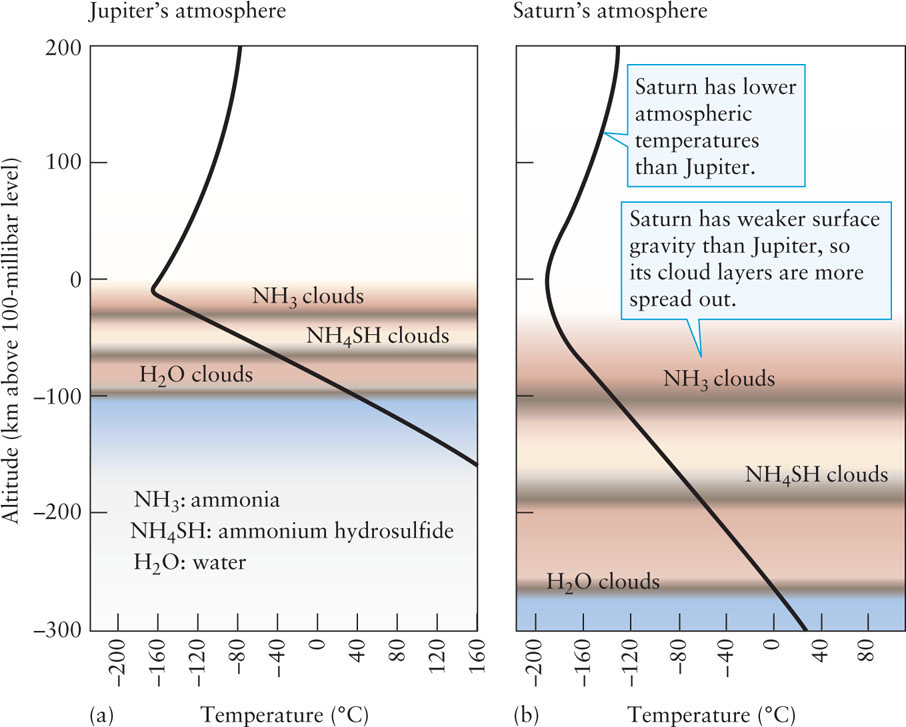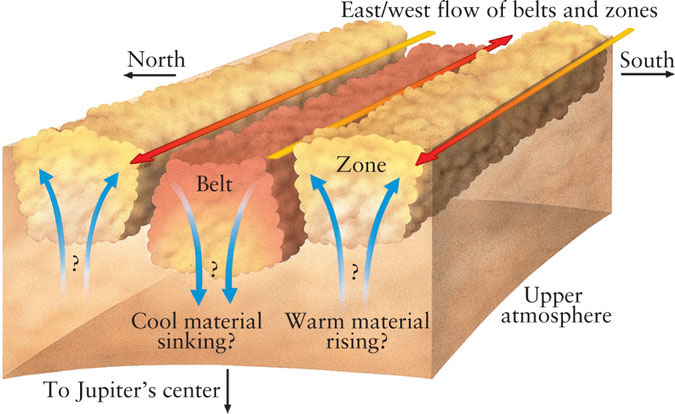12-4 The internal heat of Jupiter and Saturn has a major effect on the planets’ atmospheres
 Weather patterns on Earth are the result of the motions of air masses. Winter storms in the midwestern United States occur when cold, moist air moves southward from Canada, and tropical storms in the southwest United States are caused by the northeastward motion of hot, moist air from Hawaii. All such motions, as well as the overall global circulation of our atmosphere, are powered by the Sun. Sunlight is absorbed by Earth’s surface, and the heated surface in turn warms the atmosphere and stirs it into motion (see Section 9-1 and Section 9-5). The energy of sunlight also powers the motions of the atmospheres of Venus and Mars (see Section 11-6). On both Jupiter and Saturn, however, atmospheric motions are powered both by solar energy and by the internal energy of the planet.
Weather patterns on Earth are the result of the motions of air masses. Winter storms in the midwestern United States occur when cold, moist air moves southward from Canada, and tropical storms in the southwest United States are caused by the northeastward motion of hot, moist air from Hawaii. All such motions, as well as the overall global circulation of our atmosphere, are powered by the Sun. Sunlight is absorbed by Earth’s surface, and the heated surface in turn warms the atmosphere and stirs it into motion (see Section 9-1 and Section 9-5). The energy of sunlight also powers the motions of the atmospheres of Venus and Mars (see Section 11-6). On both Jupiter and Saturn, however, atmospheric motions are powered both by solar energy and by the internal energy of the planet.
Jupiter and Saturn: Radiating Energy into Space
In the late 1960s, astronomers using Earth-based telescopes made the remarkable discovery that Jupiter emits more energy in the form of infrared radiation than it absorbs from sunlight—in fact, about twice as much. (By comparison, the internal heat that Earth radiates into space is only about 0.005% of what it absorbs from the Sun.) About 4.56 billion years ago when Jupiter formed, it would have been about twice as large. Since then, it has contracted under its own gravity, converting gravitational energy into heat (see Kelvin-Helmholtz contractions, Section 8-4). More specifically, Jupiter shrinks as its outer layers are pulled in closer, but as this gas picks up speed, collisions between gas molecules randomize their motion and this produces heat (see Figure 5-11). Because Jupiter is so large, it has retained substantial heat, or thermal energy, even after billions of years of cooling, and so still has plenty of energy to emit as infrared radiation. Even today, the contraction continues so that Jupiter shrinks by about 2 centimeters per year.
Saturn, too, radiates into space more energy than it receives as sunlight. Because Saturn is smaller than Jupiter, it should have begun with less internal heat trapped inside, and it should have radiated that heat away more rapidly. Hence, we would expect Saturn to be radiating very little energy today. In fact, when we take Saturn’s smaller mass into account, we find that Saturn releases about 25% more energy from its interior on a per-kilogram basis than does Jupiter. The explanation for this seeming paradox may be that helium is raining out of Saturn’s upper atmosphere, as we described in Section 12-2. The helium condenses into droplets at cold upper altitudes, but generates heat at lower altitudes due to friction between the falling droplets and the surrounding gases. This heat eventually escapes from the planet’s surface as infrared radiation. This “raining out” of helium from Saturn’s upper layers is calculated to have begun 2 billion years ago. The amount of thermal energy released by this process adequately accounts for the extra heat radiated by Saturn since that time.
Heat naturally flows from a hot place to a colder place, never the other way around. Hence, in order for heat to flow upward through the atmospheres of Jupiter and Saturn and radiate out into space, the temperature must be warmer deep inside the atmosphere than it is at the cloudtops. Infrared measurements have confirmed that the temperature within the atmospheres of both planets does indeed increase with increasing depth (Figure 12-10).

ANALOGY
You can understand the statement that “heat naturally flows from a hot place to a colder place” by visualizingan ice cube placed on a hot frying pan. Experience tells you that the hot frying pan cools down a little while the ice warms up and melts. If heat were to flow the other way, the ice would get colder and the frying pan would get hotter—which never happens in the real world.
A Convection Paradox
When a fluid is warm at the bottom and cool at the top, like water being warmed in a pot, one effective way for energy to be distributed through the fluid is by the up-and-down motion called convection. (We introduced the idea of convection in Section 9-1; see, in particular, Figure 9-5.) For many years it was thought that Jupiter’s light-colored zones are regions where warm gas from low levels is rising and cooling, forming high-altitude clouds, while the dark-colored belts are regions where cool high-altitude gas is descending and being heated (Figure 12-11). However, this picture has been called into question with images made by Cassini during its 2000–2001 flyby of Jupiter, which show evidence for rising material in the dark belts.

The Fastest Winds in the Solar System
 In addition to the vertical motion of gases within the belts and zones, the very rapid rotation of both Jupiter and Saturn creates a global pattern of eastward and westward zonal winds. Wind speeds on Jupiter can exceed 500 km/h (300 mi/h). Earth’s atmospheric circulation has a similar pattern of eastward and westward flow (see Figure 9-25), but with slower wind speeds. The faster winds on Jupiter presumably result from the planet’s more rapid rotation as well as the substantial flow of heat from the planet’s interior.
In addition to the vertical motion of gases within the belts and zones, the very rapid rotation of both Jupiter and Saturn creates a global pattern of eastward and westward zonal winds. Wind speeds on Jupiter can exceed 500 km/h (300 mi/h). Earth’s atmospheric circulation has a similar pattern of eastward and westward flow (see Figure 9-25), but with slower wind speeds. The faster winds on Jupiter presumably result from the planet’s more rapid rotation as well as the substantial flow of heat from the planet’s interior.
The zonal winds on Jupiter are generally strongest at the boundaries between belts and zones. Within a given belt or zone, the wind reverses direction between the northern and southern boundaries. As Figure 12-5 shows, such reversals in wind direction are associated with circulating storms such as the Great Red Spot.
Saturn rotates at about the same rate as Jupiter, but its interior releases less heat and it receives only a quarter as much energy in sunlight as does Jupiter. With less energy available to power the motions of Saturn’s atmosphere, we would expect its zonal winds to be slower than Jupiter’s. Surprisingly, Saturn’s winds are faster! In 1980 the Voyager spacecraft measured wind speeds near Saturn’s equator that approach 1800 km/h (1100 mi/h), approximately two-thirds the speed of sound in Saturn’s atmosphere and faster than winds on any other planet. Since then, the equatorial winds seem to have abated somewhat. Between 1996 and 2004, astronomers using the Hubble Space Telescope showed that the wind speed had slowed to about 1000 km/h, and in 2005 Cassini measured wind speeds of about 1350 km/h at the equator. (These changes may be due to seasonal variations or changes in Saturn’s clouds.) Why Saturn’s winds should be even faster than Jupiter’s is not yet completely understood.
Jupiter and Saturn’s Cloud Layers
From spectroscopic observations and calculations of atmospheric temperature and pressure, scientists conclude that both Jupiter and Saturn have three main cloud layers of differing chemical composition. The uppermost cloud layer is composed of crystals of frozen ammonia. Deeper in the atmosphere, ammonia (NH3) and hydrogen sulfide (H2S)—a compound of hydrogen and sulfur—combine to produce ammonium hydrosulfide (NH4SH) crystals. At even greater depths, the clouds are composed of crystals of frozen water.
Jupiter’s strong surface gravity compresses these cloud layers into a region just 75 km deep in the planet’s upper atmosphere (Figure 12-10a). But Saturn has a smaller mass and hence weaker surface gravity, so the atmosphere is less compressed and the same three cloud layers are spread out over a range of nearly 300 km (Figure 12-10b). The colors of Saturn’s clouds are less dramatic than Jupiter’s (see Figure 12-2) because deeper cloud layers are partially obscured by the hazy atmosphere above them.
The colors of clouds on Jupiter and Saturn depend on the temperatures of the clouds and, therefore, on the depth of the clouds within the atmosphere. Brown clouds are the warmest and are thus the deepest layers that we can see. Whitish clouds form the next layer up, followed by red clouds in the highest layer. The whitish zones on each planet are therefore somewhat higher than the brownish belts, while the red clouds in Jupiter’s Great Red Spot are among the highest found anywhere on that planet.
Despite all the data from various spacecraft, we still do not know what gives the clouds of Jupiter and Saturn their colors. The crystals of NH3, NH4SH, and water-ice in the three main cloud layers are all white. Thus, other chemicals must cause the browns, reds, and oranges. Certain molecules closely related to ammonium hydrosulfide, which can form into long chains that have a yellow-brown color, may play a role. Compounds of sulfur or phosphorus, which can assume many different colors, depending on their temperature, might also be involved. The Sun’s ultraviolet radiation may induce the chemical reactions that produce these colorful compounds.
CONCEPT CHECK 12-4
Why are Jupiter’s cloud layers more compressed than Saturn’s?
Jupiter has significantly more mass, and as a result the cloud layers are gravitationally compressed much more on Jupiter than on less massive Saturn.